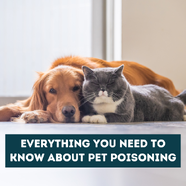Everything You Need to Know About Pet Poisoning: Prevention, Signs, and What to Do!
Author: The Vet Shed Date Posted:23 March 2025

March is National Pet Poisons Prevention Month, a time to raise awareness about the dangers that everyday household items, outdoor plants, and more can pose to our beloved pets. We hope you’ll take a few minutes to read this blog, because it just might save your pet's life!
Why is pet poisoning a concern?
Our pets are naturally curious, always sniffing around and getting into things they shouldn't. Unfortunately, this curiosity can sometimes lead to serious consequences if they come into contact with poisonous substances. Pet poisoning is a real threat, and it can cause severe illness or, in some cases, even be fatal for our furry friends.
What are the common poisons to pets?
There are many potential poisons that can harm your pet, both inside and outside the home. Some of the most common ones include:
-
Foods: Chocolate, grapes, raisins, onions, garlic, and alcohol can all be toxic to pets, even in small amounts.
-
Plants: Many household and outdoor plants, like lilies, azaleas, and poinsettias, can be harmful if ingested.
-
Medications: Human medications such as painkillers, antidepressants, and cold medicines can be fatal if consumed by pets.
-
Chemicals: Cleaning products, antifreeze, pesticides, and even some paints can be extremely dangerous.
-
Household items: Items like batteries, certain toys, and rubber bands can also pose a poisoning risk if chewed on or swallowed.
It’s important to be aware of these common hazards and take steps to keep them out of your pet’s reach.
.png)
How can you prevent pet poisoning?
Preventing pet poisoning starts with being proactive and creating a safe environment for your furry friend. Here are some simple steps to protect your pet:
- Secure Dangerous Substances: Keep all medications, cleaning supplies, and chemicals in cabinets that your pet can't access. Store these items safely and out of reach.
- Pet-Proof Your Home: Check your home for potential hazards, like toxic plants or small items your pet could swallow. Make sure your trash cans are pet-proofed, and never leave food unattended.
- Monitor Outdoor Areas: Be cautious when walking your dog or letting them roam outside. Keep an eye out for toxic plants, pesticides, or other hazards in your yard or while on walks.
- Be Mindful of Food: Don’t feed your pet human food, and keep toxic foods like chocolate, grapes, and onions well out of reach.
- Know Pet-Safe Plants: Only keep non-toxic plants in your home and garden, and ensure any potentially harmful plants are out of your pet’s reach.
What are the signs and what should you do if your pet is poisoned?
Pet poisonings can be incredibly frightening for owners, often bringing a sense of uncertainty and panic. That’s why it’s so important to stay aware of your pet’s regular behavior. Knowing what’s normal for them allows you to spot any changes quickly, and acting fast in these situations can make all the difference in saving your pet’s life.
Common signs of poisoning in pets include:
- Vomiting or diarrhea
- Excessive drooling or foaming at the mouth
- Lethargy or weakness
- Loss of appetite
- Seizures or tremors
- Difficulty breathing
- Unusual behavior or confusion
If you suspect your pet has been poisoned, here’s what you should do:
- Stay Calm: It’s important to remain calm so you can act quickly and effectively.
- Identify the Poison: If possible, determine what your pet may have ingested or been exposed to. This can help your vet provide the best treatment.
- Call for Help: Contact your vet or the Animal Poisons Helpline - 1300 869 738 immediately. They will guide you on the next steps and may ask you to bring your pet in for treatment.
- Follow Professional Advice: Don’t try to treat the poisoning at home unless directed by a professional. Some treatments could make things worse. The quicker you respond, the better the chances are for your pet’s recovery. Keeping emergency contact numbers handy and knowing the signs can help you react quickly when every second counts.









